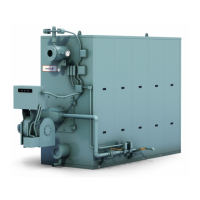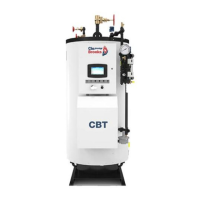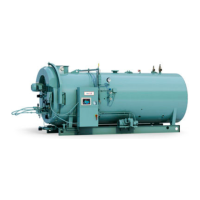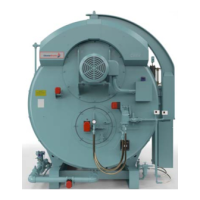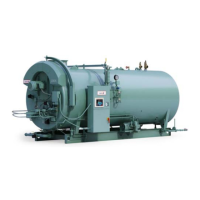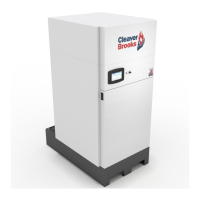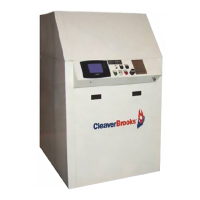Chapter 2 Profire V Burner
2-36 750-177
butterfly valve should be near the full open position. Adjust the gas regulator so the manifold pressure matches the
rating on the burner data plate. Verify and record the readings and pressures. high-fire is typically 3% to 4% O2
with less than 50 ppm CO.
7. Adjust the low and high gas pressure switches by turning the adjusting screw until the indicator moves to a pres-
sure slightly lower than normal operating pressure for the low gas pressure switch, and slightly higher for the high
gas pressure switch (usually 20% below and 20% higher than normal pressure).
8. Verify low-fire and high-fire rate by clicking the meter as previously explained.
9. After completing all adjustments, replace the regulators, gaskets, and slotted aluminum screw caps. Tighten all
linkages and marked settings. The burner should be adjusted to provide correct fuel flow at a constant rate, as indi
-
cated on the burner data plate. Complete the Startup Report.
FULL MODULATION GAS BURNER ADJUSTMENTS
The burner adjustments on a full modulation gas burner consist of the gas pressure regulator, butterfly gas
valve, low nad high gas pressure switches (model V30-168), and air dampers.
1. Open the manual gas shutoff cocks.
2. Check the gas pressure at the inlet of the regulator and the pressure downstream of the regulator. Make sure they
are in accordance with the regulator specifications. The gas pressure required at the manifold is the pressure that is
required to fire the burner at its rated capacity. To adjust the regulator, unscrew the cap located on the top and turn
the adjustment screw clockwise to increase pressure, or clockwise to decrease pressure.
3. Set the “MANUAL-AUTO” switch to the “MANUAL” position.
4. Position the manual flame control potentiometer in the “CLOSED” (low-fire) position.
5. Turn the burner switch to the “ON” position. The burner will start and be in the low-fire position.
6. After a few seconds, the O2 analyzer should have an accurate reading of the O2 present in the flue gas. Normally,
O2 levels are set between 4% to 6% at low-fire for standard turndown systems on gas and 6% to 9% O2 for high
turndown systems, with the target value of less than 50 ppm CO. To obtain the proper readings, adjust the air shut
-
ter and low-fire regulator pressure.
7. Operate the boiler at low-fire until it is up to operating pressure (steam) or temperature (hot water). Then increase
the fuel input to the boiler by turning the manual flame control potentiometer towards “OPEN” in small increments.
This will cause the butterfly valve to open, allowing more gas into the burner.
8. At each point allow the burner to operate for a few minutes before recording the O2, CO, and pressure readings.
Observe that the O2 and CO levels remain within an acceptable limit. Adjust the pressure regulator as necessary to
correct this situation. Continue to do this until the burner reaches high-fire (the potentiometer is at the “OPEN”
position).
9. Adjust the high-fire gas input to match maximum rating. At high-fire, the butterfly valve should be near the full
open position. Adjust the gas regulator so the manifold pressure matches the rating on the burner data plate. Verify
and record the readings and pressures. high-fire is typically 3% to 4% O2 with less than 50 ppm CO as a target
value.
10. Modulate the burner to low-fire. Verify the readings. The burner should be adjusted to provide correct fuel flow at a
constant rate, as indicated on the burner data plate.
11. Adjust the low and high gas pressure switches by turning the adjusting screw until the indicator moves to a pres-
sure slightly lower than normal operating pressure for the low gas pressure switch, and slightly higher for the high
gas pressure switch (usually 50% below and 50% higher than normal pressure, respectively).
12. Tighten all linkages and marked settings. Complete the Startup Report.
13. Turn the “MANUAL-AUTO” switch to “AUTO”. The burner will now modulate according to the load demand to the
boiler.
